What
Oscar
AUTHORED BY
Mario Schlosser
President of Technology
and Co-founder
Does



America spends twice the portion of its GDP on healthcare compared to any other rich country in the world for results that are no better — and in many instances worse.
Despite its high cost, our healthcare system is full of nightmarish stories — of complex, impossible to read bills and unpredictable prices, and bad outcomes for patients.
The core issue with U.S. healthcare is that it is theoretically structured as an open marketplace, but without any of the transparency or competitive pressures that an open marketplace requires. So we end up in the worst case scenario: no universal access, high costs, and little consumer orientation.
Oscar aims to change this by making a healthier life accessible and affordable for all. We do this by refactoring healthcare to make great care cost less.
Refactor means to improve the design, structure, and implementation of the software, while preserving its functionality. At Oscar, we take this definition a step further. We improve our members’ experience by building trust through deep engagement, personalized guidance, and rapid iteration.
Oscar was founded just about a decade ago, in anticipation that the U.S. healthcare industry would shift towards a more (1) consumerized, (2) digital, and (3) value-driven system. We’ve witnessed this shift occur over recent years, which not only validates our strategy but has provided us with a first mover advantage.
Since inception, we have focused on a consumer-centric model, putting us in a position to easily take advantage of the first trend towards consumerization. We believe that the ACA market, a consumer-driven market which has proven to be the fastest growing segment in health insurance in recent years, is both stable and sustainable. Based on the latest data from CMS, it is projected to grow to 16M individuals in 2023, and to hit 20M in the near-term. We expect further growth in the ACA in future years, and as one of the largest ACA carriers, we expect to benefit from this market shift.
Following the trend towards digitization, we’ve been able to realize the value of our digital tools, while others are just now trying to build this from scratch or piece together existing solutions.
By investing early on in areas that others did not — technology and member engagement — we’ve built a differentiated business model that has earned us the trust of over 1M members.
This investment has also given us scale in our operations that we are now leveraging to drive down administrative costs. Our tech investment in our member experience created a defensible moat around our product that we can now leverage in other areas as we bring the business into profitability.
Finally, the market is also shifting more towards risk-sharing. We’ve been implementing this model in our own provider partnerships as a way to empower providers and ensure a higher level of care for our members. Currently, 48% of our members are attributed to a value-based arrangement, and we are working to increase this number because we have found these arrangements drive better clinical outcomes at lower costs. It is our belief that the system will continue on this path, resulting in a healthier dynamic between providers, payers, and patients.
Our ability to anticipate these trends has been critical to our near and long-term growth and sustainability as a company. Over the past five years we have seen a ~75% compound annual growth rate for direct and assumed policy premiums. We have also improved our Medical Loss Ratio (MLR) by more than 12 pts since 2017 and have made meaningful strides to improve the fundamentals of our business. Through all of this, we have never sacrificed what matters most - the quality of our member’s experience and their ability to get the care they need for themselves and their families. We now have an all-time high NPS score of 47.
Scaling, operating, and driving industry change takes time, but we have shown that, despite being a newer player challenging legacy incumbents and navigating a complex environment, we've been able to make significant progress and impact a deeply entrenched system.
In this document, we’ll describe the following:
The Overview
Our perspective on the systemic issues in U.S. healthcare

If we want to address the systemic issues within U.S. healthcare and drive innovation, the healthcare market needs to become more consumerized, digital, and interoperable, particularly when it comes to how we finance care.
Financing care and other core activities that an insurer performs are necessary components of the healthcare system — but they should be simpler, more tech-driven, and API-accessible.
The machinery we’ve been building since Oscar’s founding allows us to be uniquely suited to take advantage of these trends, power more of the system, and help transform the industry.
We have invested heavily in the modernization of the core activities of a great health insurer:
We also believe in enabling an “unbundled” risk-based model where:
- any healthcare service becomes an insurance-like product
- everything can be a personalized incentive
- lifelong relationships motivate well care
- anything can be a network & everyone shares in long-term outcomes
When looking at the macro level, healthcare may seem to be evolving slowly — but we are seeing meaningful shifts toward individualization, digitization, and value-based care. And any such healthcare system will need the kind of technology we have built.
In other words: (1) the market structure of U.S. healthcare has some very specific issues, (2) health insurers are in a position to address these issues, (3) but they need a more modern way of operating, and (4) should make themselves obsolete by unbundling their capabilities.
Four reasons why the market structure of U.S. healthcare doesn’t work:
01 Financial incentives are misaligned →
02 Prices rise faster without consumer pressure →
03 No market mechanism forces costs and quality into line →
04
01
Financial incentives are misaligned, because most healthcare services still get reimbursed as fee-for-service
If everyone gets paid for utilization and not outcomes, it’s no surprise that we get more utilization and not better outcomes. While reimbursements have shifted towards paying for value, value-based payments still only made up 6.7% of primary care revenue in 2021,1 and even less for health systems.
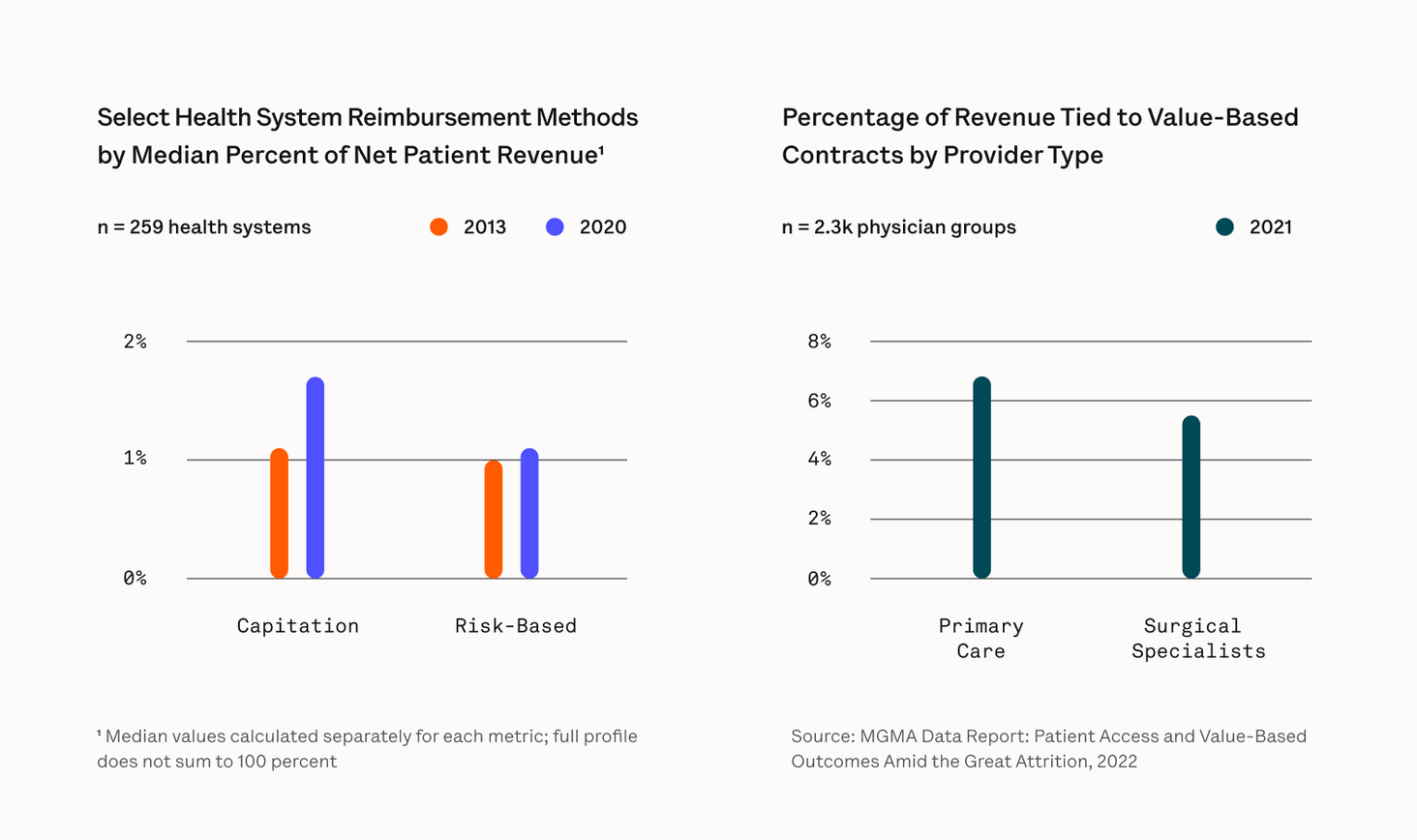
02
In markets without end consumer pressure, prices rise faster
Most consumers can’t vote with their feet and thus put competitive pressure on the players within the healthcare system. Markets that have consumer pressure perform better: for example, for elective procedures where consumers can vote with their feet, prices have developed very differently.


Similarly, monthly premiums in the individual ACA market have risen much more slowly than premiums in the employer market (where another year of big increases is expected in 2023). Easily comparable, transparent pricing with relatively simple sign-up processes all make a big difference in the ACA market.

We see this dynamic at work even for individual services in the healthcare market. Compare over-the-counter (OTC) versus lab (PCR) testing for covid. OTC covid tests are obviously a lot cheaper. But more interestingly, there is also a lot less price variance for OTC than for PCR tests. Why is that, if both are equally commoditized at scale? Because one gets bought off the shelf by consumers, whereas the other gets reimbursed behind the scenes by insurers. It is this kind of unjustified price variance (different price for the same service) where a lot of dollars leak out in healthcare.
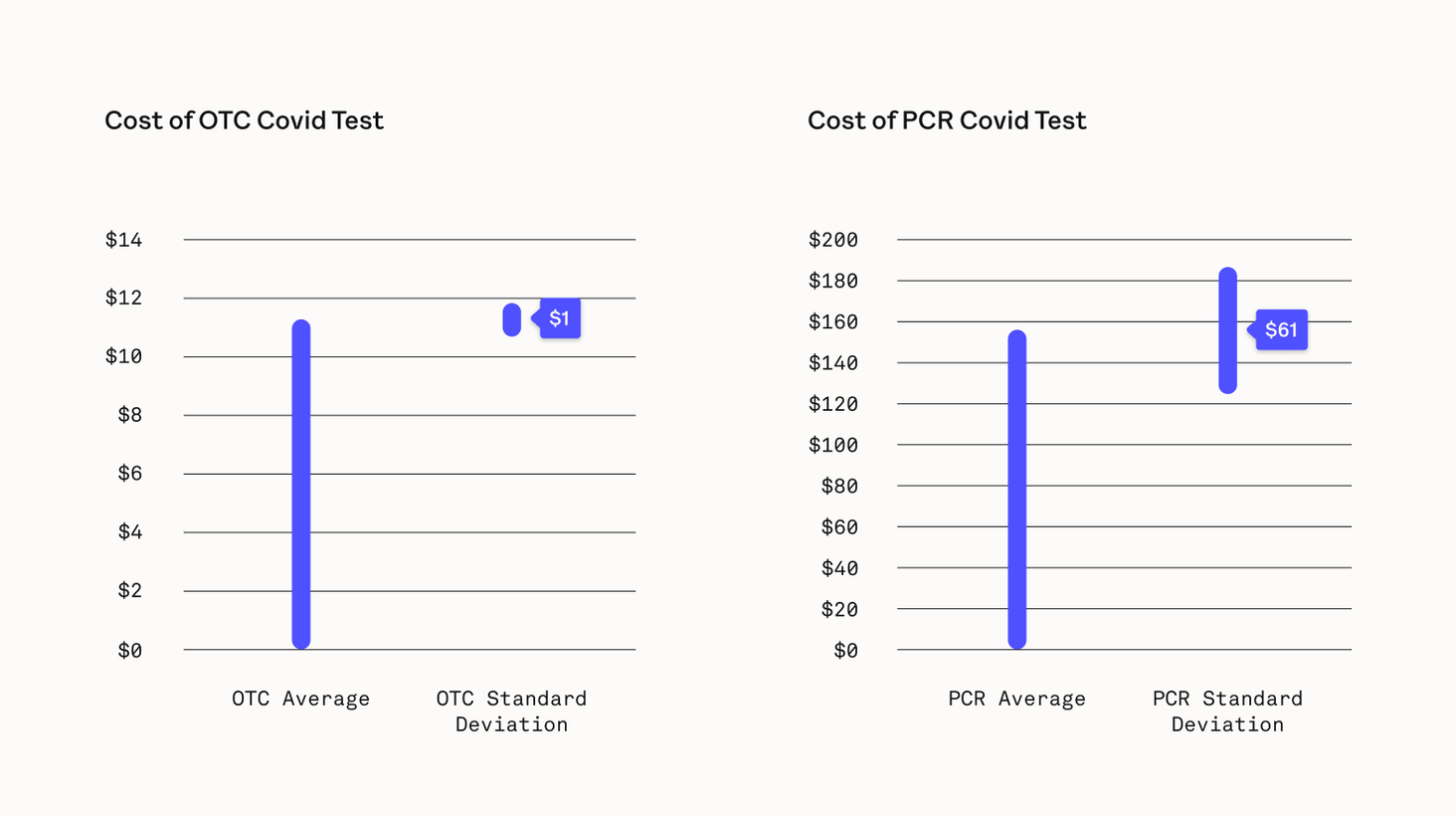
03
As a result, unlike in every other consumer-driven market, no market mechanism forces costs and quality into line
We can see even in our own data that high physician costs don’t necessarily correlate with high-quality outcomes or higher member satisfaction.
Vel elit scelerisque mauris pellentesque pulvinar pellentesque habitant morbi tristique
Vel elit scelerisque mauris pellentesque pulvinar pellentesque habitant morbi tristique
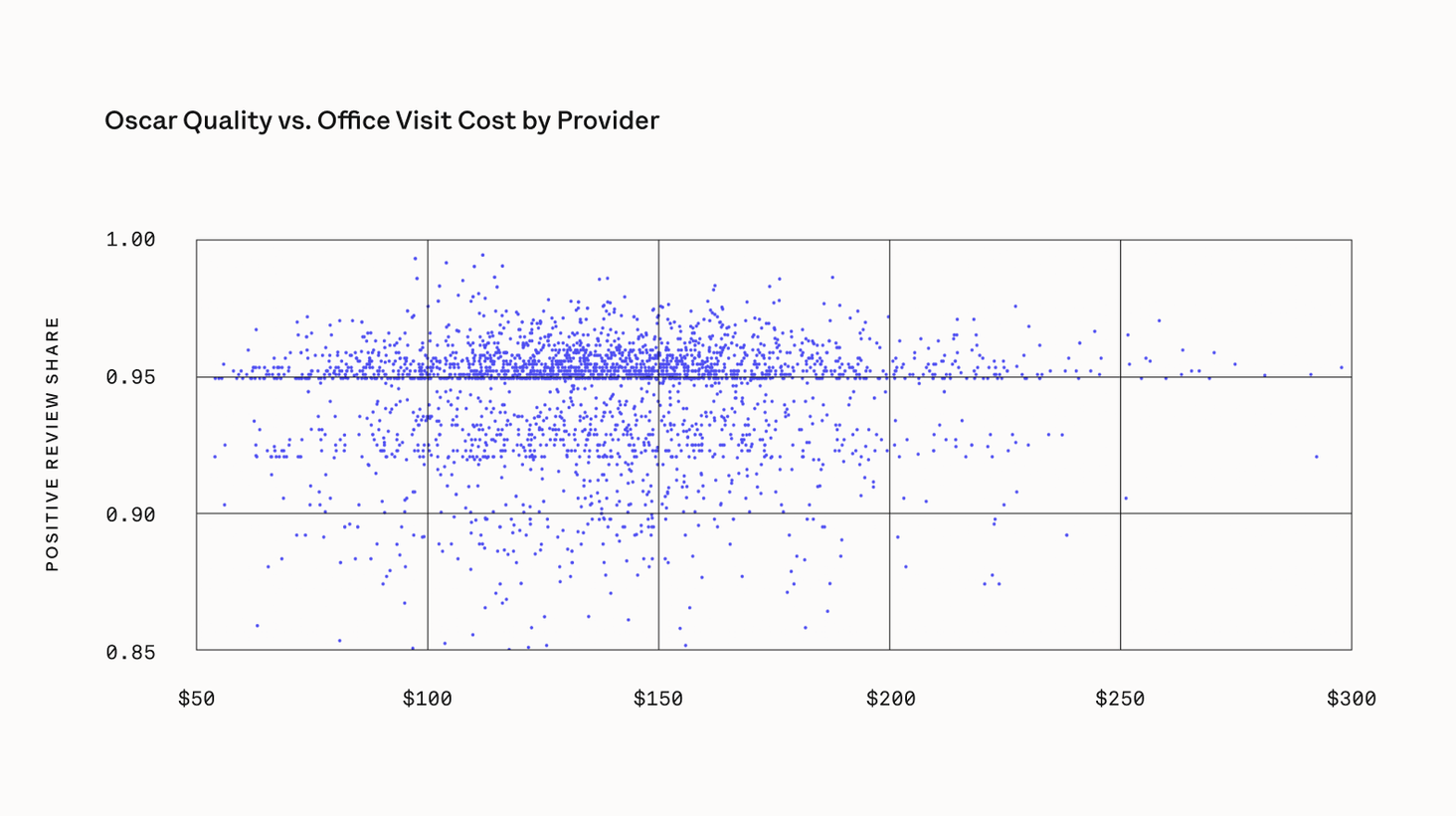
There is also little to no correlation between the prices a hospital charges and its star ratings.
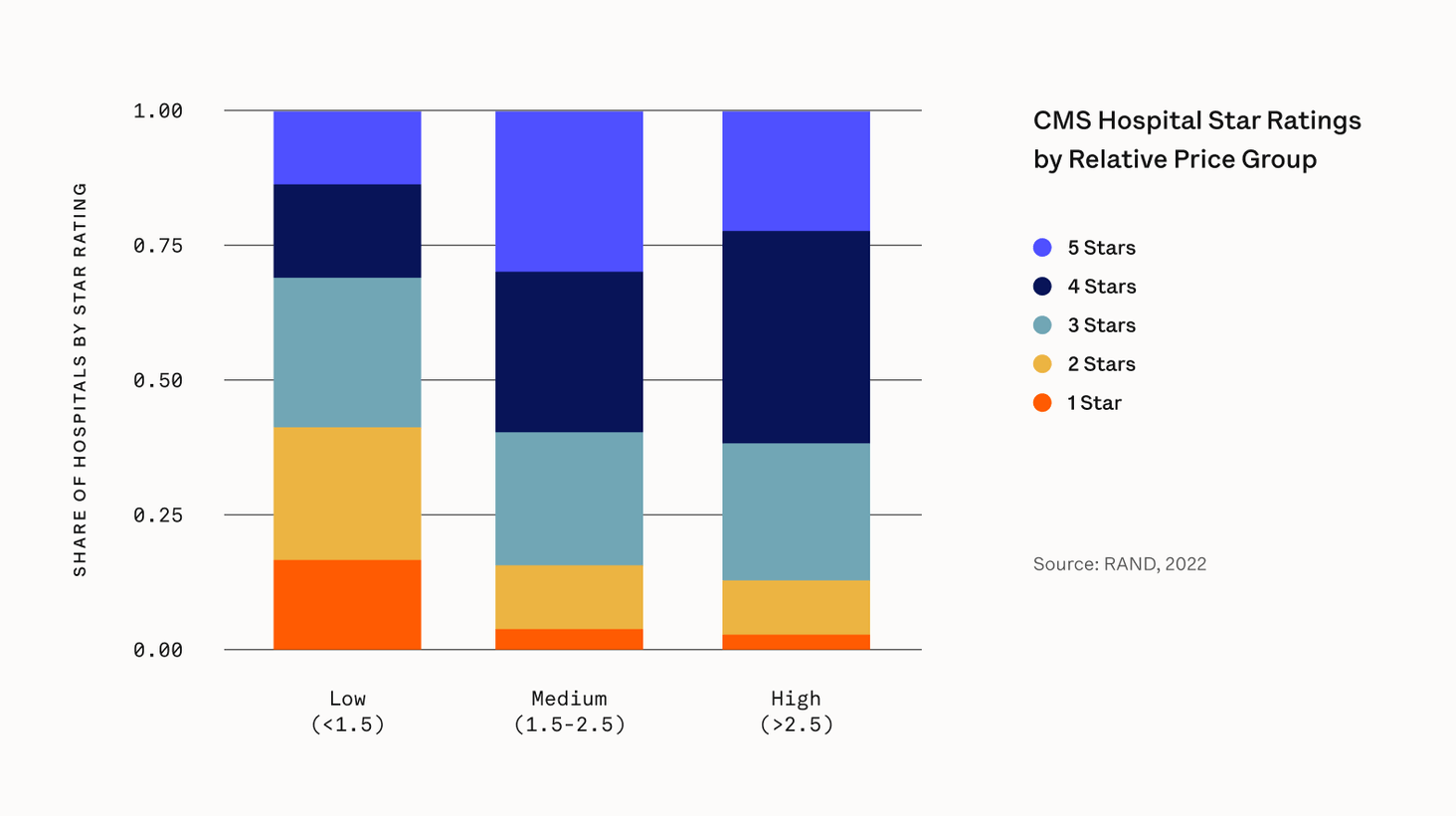
04
As a result, there is little incentive for providers or payers to build longer-term economic relationships and build a great member experience
If the healthcare market doesn’t pay for driving higher quality, how can healthcare players justify economically to drive member retention, and much longer-term relationships? They can’t, and it shows:
- The average insurance member tenure is ~3 years.2
- Private payers spend $27.1B a year on marketing and sales, while hospitals and physicians only spend about $3B.3
- With an average Net Promoter Score, or NPS, of three, according to Forrester Research, customer satisfaction for health insurers ranks among the lowest of any industry.
Healthcare today is not structured to incentivize the build of great solutions that eliminate inefficiencies and increase quality. However, health insurers do hold a lot of the cards to change that.
Let’s explore.



01 Acquire Premium Revenue

→
→
→
→
→
02 Identify and Reduce Risk Per Member

→
→
→
→
→
03 Authorize Care

→
→
→
→
→
04 Manage Cost of Utilization

→
→
→
→
→

Insurers are needed for four core things
Insurers do four core things that are critical within the system:
02 Identify & reduce risk per member →
03 Authorize care →
In fact, those four things neatly fit into the formula that determines an insurer’s financial performance. Let’s take a look at each.
Risk
Member
Utilization
Risk
Cost
Utilization
Premium Revenue


This is a member’s basic health risk (a chronically ill diabetic, a cancer patient, a healthy 35-year old).


This is a member’s utilization relative to her risk (a diabetic can get well managed care by a great primary care physician, or end up in the ER too often).


This is the cost per utilization (for example, the difference in cost for the same MRI, even at the same hospital, can be 3x).
01
Insurers acquire premium revenue
Paying for healthcare only works if costs are distributed among healthy and sick people. Insurers are the ones who form those risk pools in today’s system. But today’s acquisition models in insurance are disintermediated, commoditized and impersonal, because this mostly means building sales pipelines into HR departments, and managing brokers and general agencies.
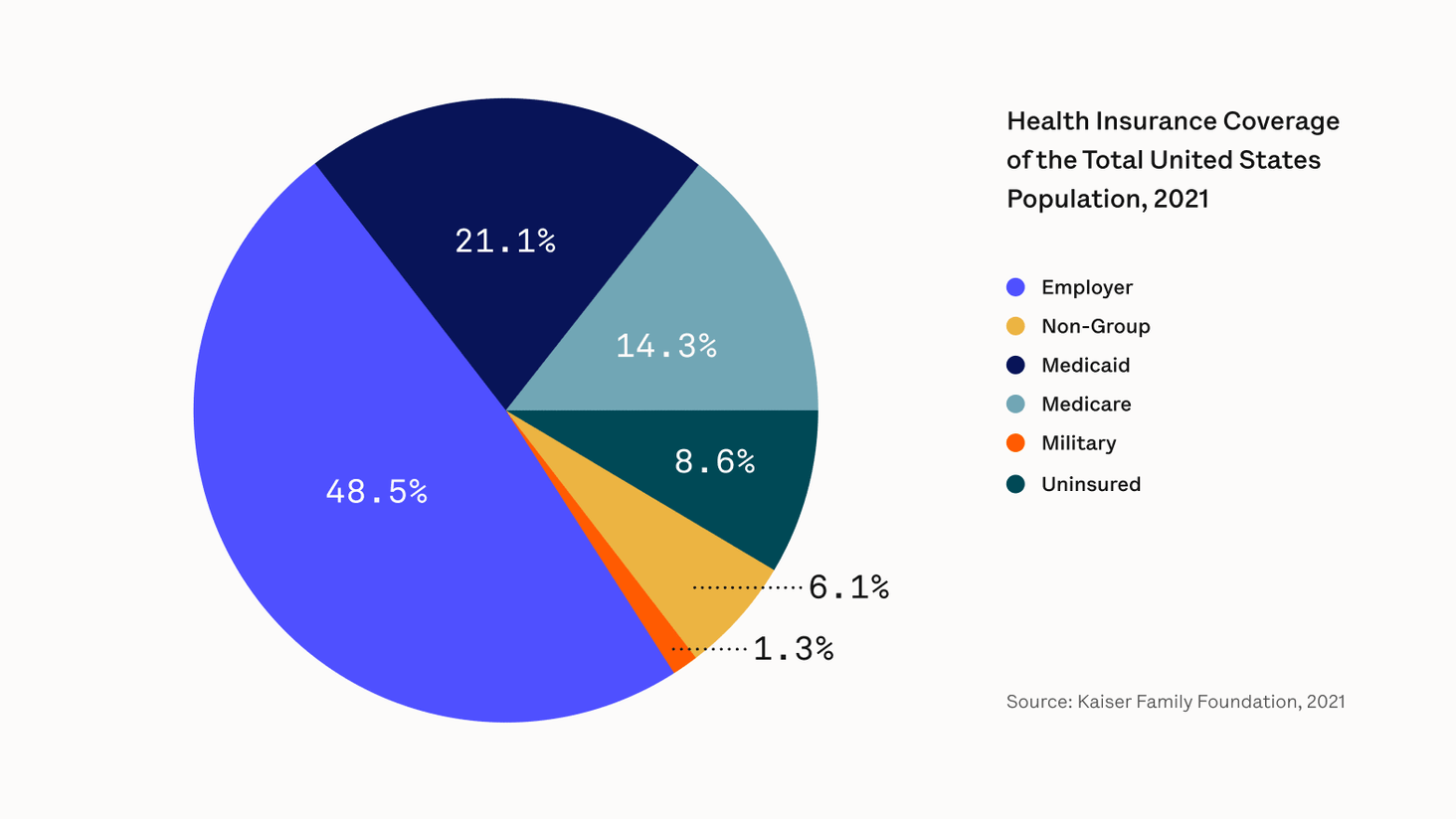
02
They identify and try to reduce risk per member
In any given risk pool, someone needs to identify health risks and work to reduce them. Today, that means insurers do underwriting, capture risk scores, and make limited investments in members’ wellness. There are some incentives to do this, but those can lead to misallocations of their own. For example, rather than using the insurer’s power to identify risk to drive better outcomes, identifying risk has become a business in and of itself. As seen below, the 11-percentage-point increase in measured relative risk from 2007 to 2015 appears largely to be the result of differences in coding patterns between Medicare Advantage and traditional Medicare — meaning, Medicare Advantage plans just spend a lot more effort on identifying members with existing conditions.4 There is no commensurate rise in outcome differences between those two segments.
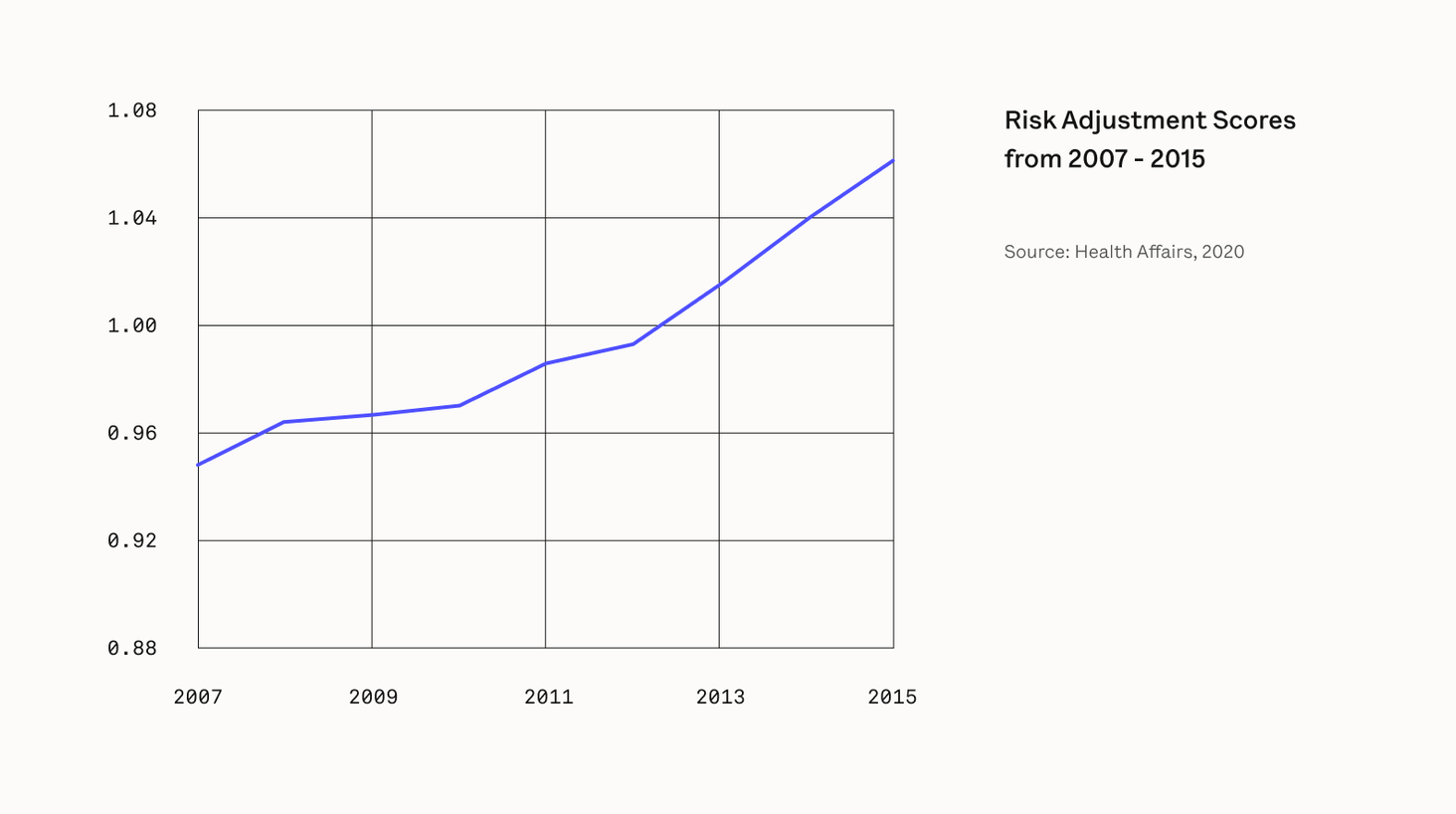
03
They authorize care
In any given member population, someone needs to make sure the necessary and most effective kind of care happens. Today, that means most care is managed through insurer denials and blunt financial incentives. Insurers are using (1) medical management (prior authorization, utilization management) to steer people to the right care, and (2) high deductibles and cost-sharing to manage utilization.
For example, the shift towards high deductibles in the employer market has been quite recent, and astounding: the percentage of employees with deductibles greater than $1,000 went from barely recognizable to over 60% in 15 years.5,6

These blunt incentives have issues. A 2022 study shows that low-income employees in high-deductible plans have increased ER spend and depressed primary care spend7 — exactly the wrong kind of utilization to lower healthcare costs and improve outcomes.
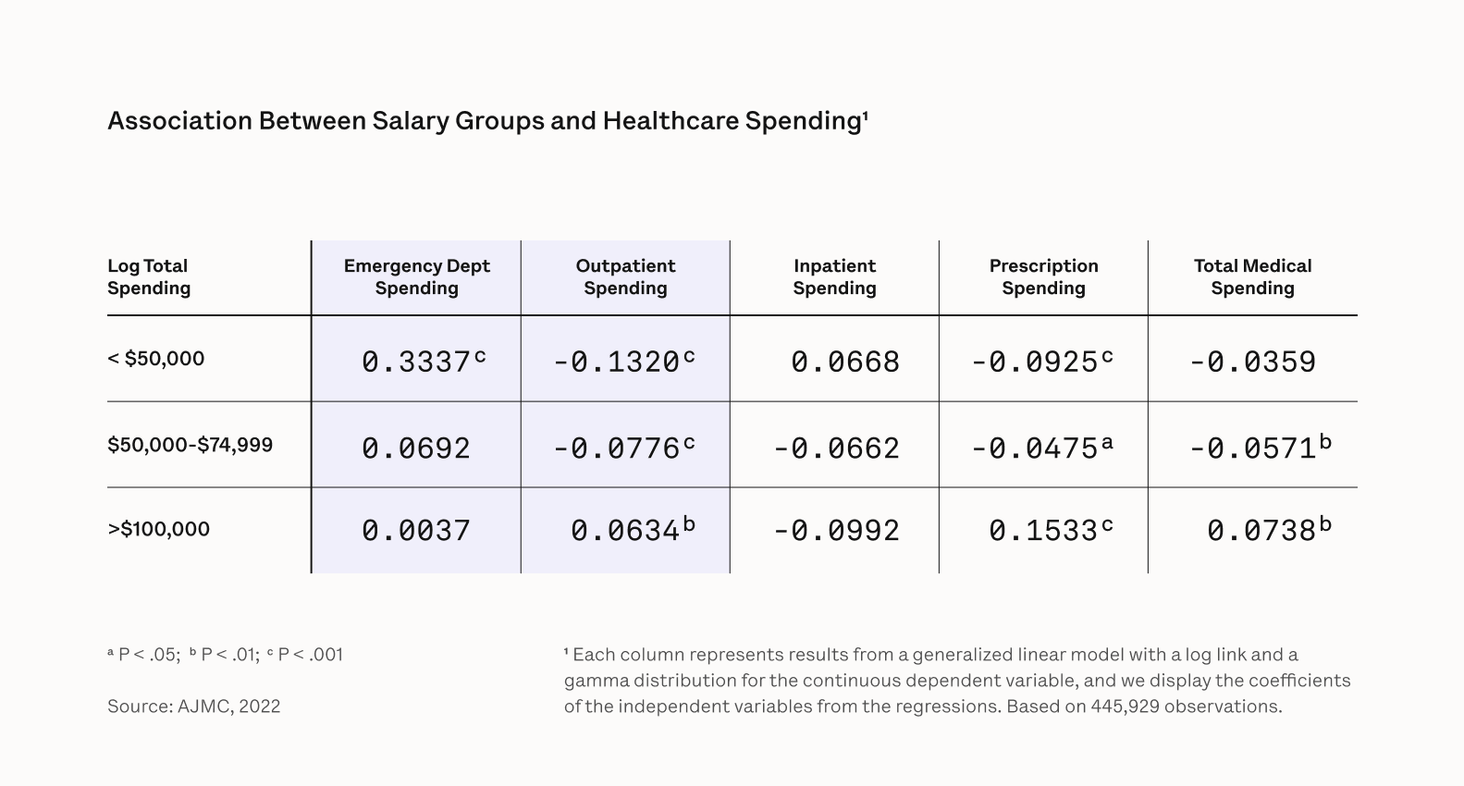
Another recent study showed that diabetic patients that were forced to enroll in a high-deductible health plan by their employer faced a higher risk of acute diabetes complications compared to those enrolled in traditional health plans.8
04
They manage cost of care delivery
In any given health plan, someone needs to set the rates by which healthcare utilization gets reimbursed. Today, that means insurers contract a network of providers.
The problem with leaving that to the insurer is that they often aren’t able to drive competitive pricing particularly well, or consistently, which recent price transparency data shows.
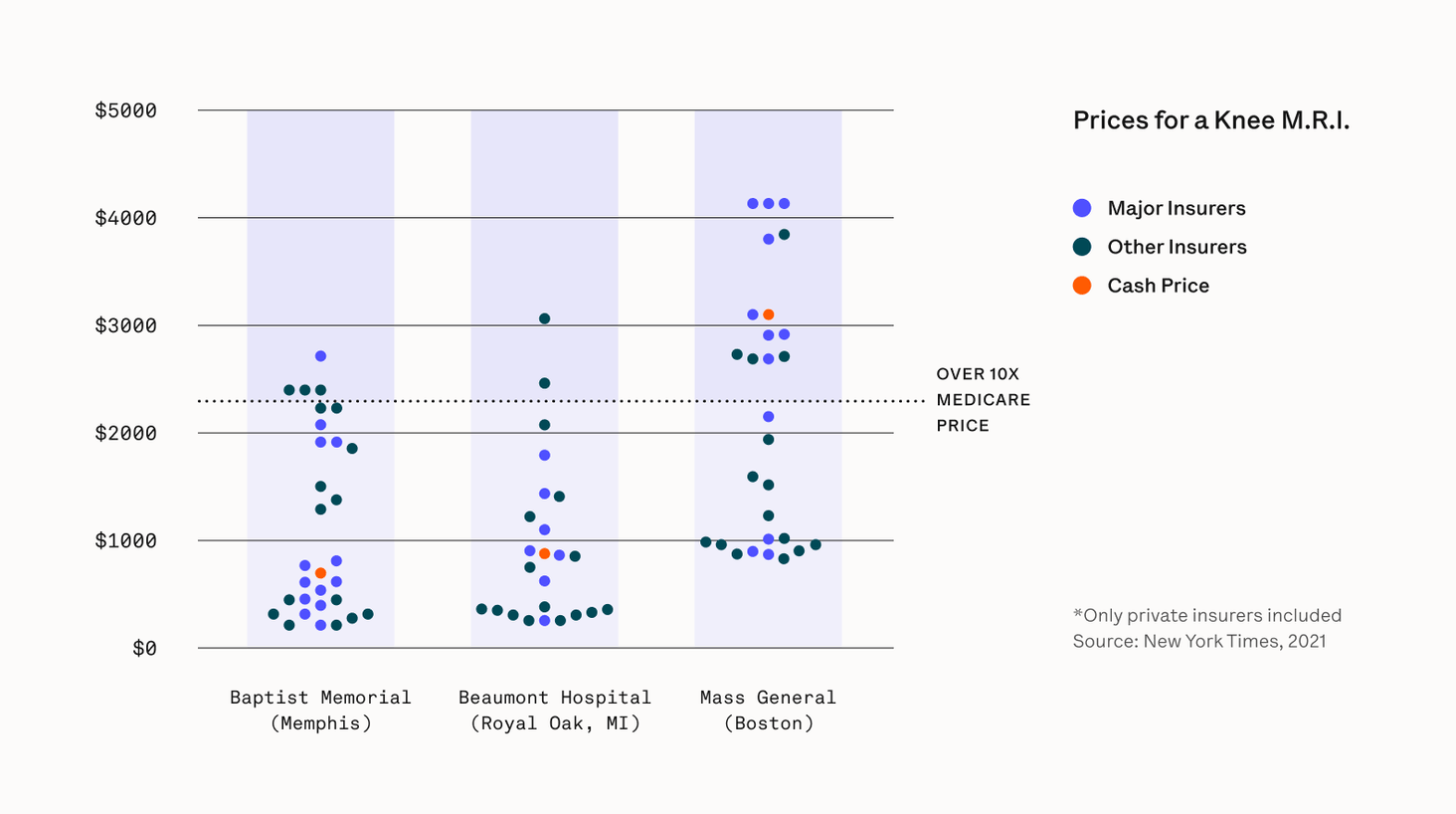
In summary: if we want better outcomes at lower costs, then someone in U.S. healthcare needs to be paying attention to the healthcare economics formula we showed further up. Today, we largely leave that to insurers: they collect premium revenue, manage risk per member, manage utilization per risk, and manage cost per utilization.
The core activities that an insurer performs are indeed necessary components of the healthcare system — but they should be simpler, more tech-driven, and API-accessible, and thus enable others in the healthcare system to perform them.
It’s possible that they don’t need to be done by an insurer at all.
This is where Oscar comes in. We aim to be a great health insurer, and then unbundle the core building blocks of an insurer. This will enable us to help others in the healthcare system build on those to create a more consumer-centric, economic healthcare system, which could free up hundreds of billions of dollars in savings.9
For us, the two activities of (a) building a great insurer, and (b) unbundling it, are synergistic. We can build a piece of technology once, and use it twice — to grow our own risk business, and to help others build/grow theirs.
In a consumer-centric healthcare market, the company offering the lowest predictable total cost of care with the best member experience wins. So, improving the Oscar experience is core to our business model. When people have a better experience — armed with more confidence about the choices they are making — they can save money and become healthier.
Modernizing the core activities of a great health insurer

These are the four components we have built for our insurance business:
01 Personalized sales process & creative product design →
02 Easy payment flows & real-time insights →
03 Manage care through persuasion & personalized relationships →
01
Modernizing: Acquire Premium Revenue
Personalized sales process & creative product design
We believe the best way to acquire members, and add value to the healthcare system, is by personalizing the product and the sale. Rather than focusing on broad, one-size-fits-all marketing and sales efforts, we aim to create plan designs that meet specific needs, are affordable, and can influence utilization. Our results support the hypothesis that there is a latent need for a more customized approach to plan design, to marketing, and to selling.
Fine-tune plan designs for particular diseases
Oscar launched diabetic plan designs to improve the outcomes and lower costs for our members living with diabetes.
The plan lowers cost-sharing for high-value diabetic related services and supplies, such as $0 diabetic eye and foot exams, $0 labs to manage diabetes, and a cap for out of pocket costs for insulin. This gives members with diabetes certainty on their overall cost and can help drive adherence.
When we launch these plans, we see high levels of engagement from eligible members. And we know that our members who engage with our product features are more likely to stay with us year over year.
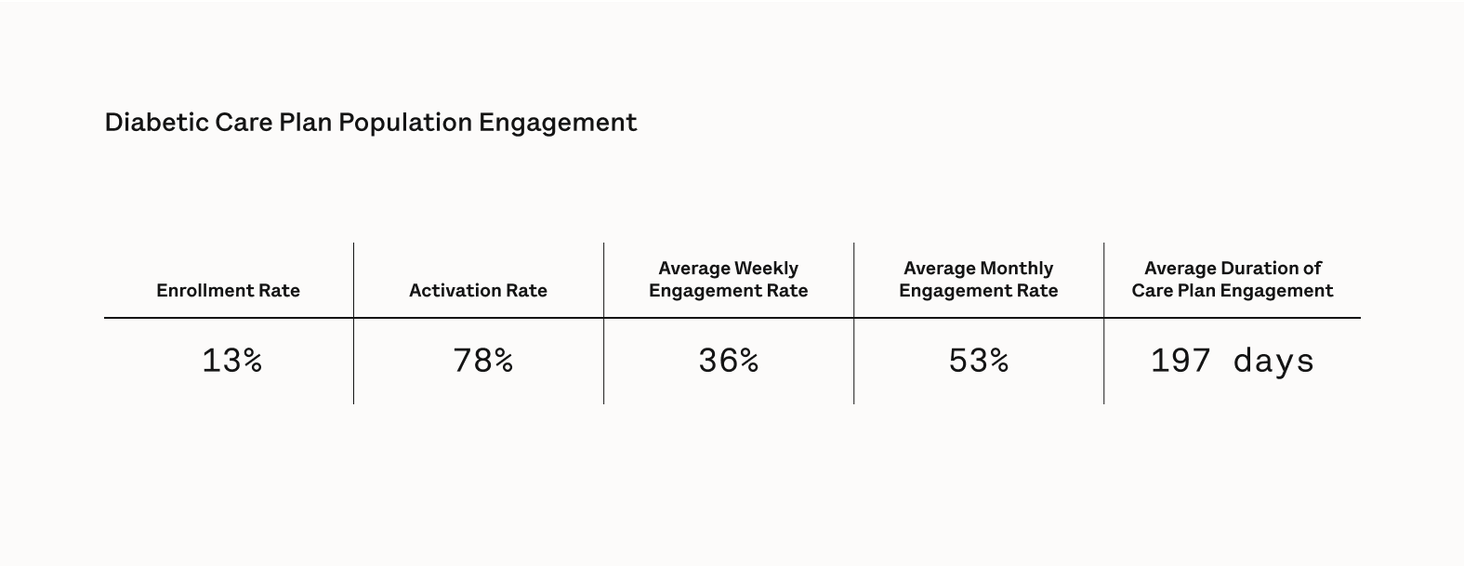
Create plan designs around alternative channels of care
We were the first to offer $0 access to 24/7 telehealth for urgent care needs, going back all the way to 2014. In 2021, we launched our Virtual Primary Care plans, as a natural extension of that offering.
Our Virtual Primary Care plans offer members access to $0 virtual primary care visits through a dedicated team of experienced providers. We went a step further in the design of our plans to incentivize members to follow through on the care plan that’s developed by their virtual primary care provider. For example, if their vPCP prescribes a Tier 1 medication, we waive the cost share on that medication. The same is true for labs and other important services.
Our Virtual Primary Care plans have been well received by members — 97% of members on our virtual plans that have used the virtual primary care program would recommend it.
These plans have also outperformed the rest of our network on numerous quality metrics: including eye exams, and cervical, colon, and breast cancer screening rates.


Engage members in alternative channels
We’ve developed a digital experience that is easy-to-use for members. Oscar’s member app is designed to help our members with common healthcare problems by providing the kind of simple, straightforward experience consumers expect. 42% of our members are monthly active users.
We have also continued to iterate on our digital experience to make engagement easier — even for our members who are hesitant to download our app. In 2022, we launched applets, a digital interface that allows members to take discrete actions based on prompts we send them via text or email. These applets can be launched within 15 minutes of ideation and will lead to even greater levels of engagement in 2023.
Talk to members in more personal ways
MyIdentity is a good example for how we build member trust through a differentiated brand voice, no matter the members’ health status or background. This functionality allows all members – including those who identify as transgender or non-binary – to freely input their name, pronouns, and gender identity in the Oscar experience as a part of the company’s ongoing efforts to ensure that members get the access to care they need in an equitable way.
On a weekly basis, almost a quarter of our members engage with one of our outbound communications that are customized based on their information and data.
Make the buying process more comfortable
Health insurance is notoriously complex and cumbersome to buy. Curiously, even brokers often feel that way, because insurers make the process so clunky. The Oscar Broker Portal is a one-stop-shop for doing business with Oscar. It allows brokers to get appointed in under 5 minutes, and then manage anything from commissions, to enrollment, to driving their members’ engagement.
- This past Open Enrollment (OE), we saw 47.9k appointed brokers, and 63% of these were active writing brokers.
- 70% of writing brokers logged into the portal at least once during the past OE.
- Brokers love it: 78% of brokers found Oscar’s account creation/app useful to some or all of their book of business. We want brokers to help get their members to the right doctors, and 87% say that the provider search tool was beneficial to some or to all of their book of business.
02
Modernizing: Identify & Reduce Risk per Member
Easy payment flows & real-time insights
Payment flows in healthcare provide deep insights into risk and care of a population. But they are slow and cumbersome and often fail to live up to that potential. Between 5%-25% of claims get denied by insurers,10 depending on the segment. And 20% of claims get processed manually by insurers.
Make payment flows simpler and faster
We built our own payments system at Oscar. It enables us to develop much more complex plan designs, move faster, and importantly to see more data more quickly. We also want to keep reducing our processing time.
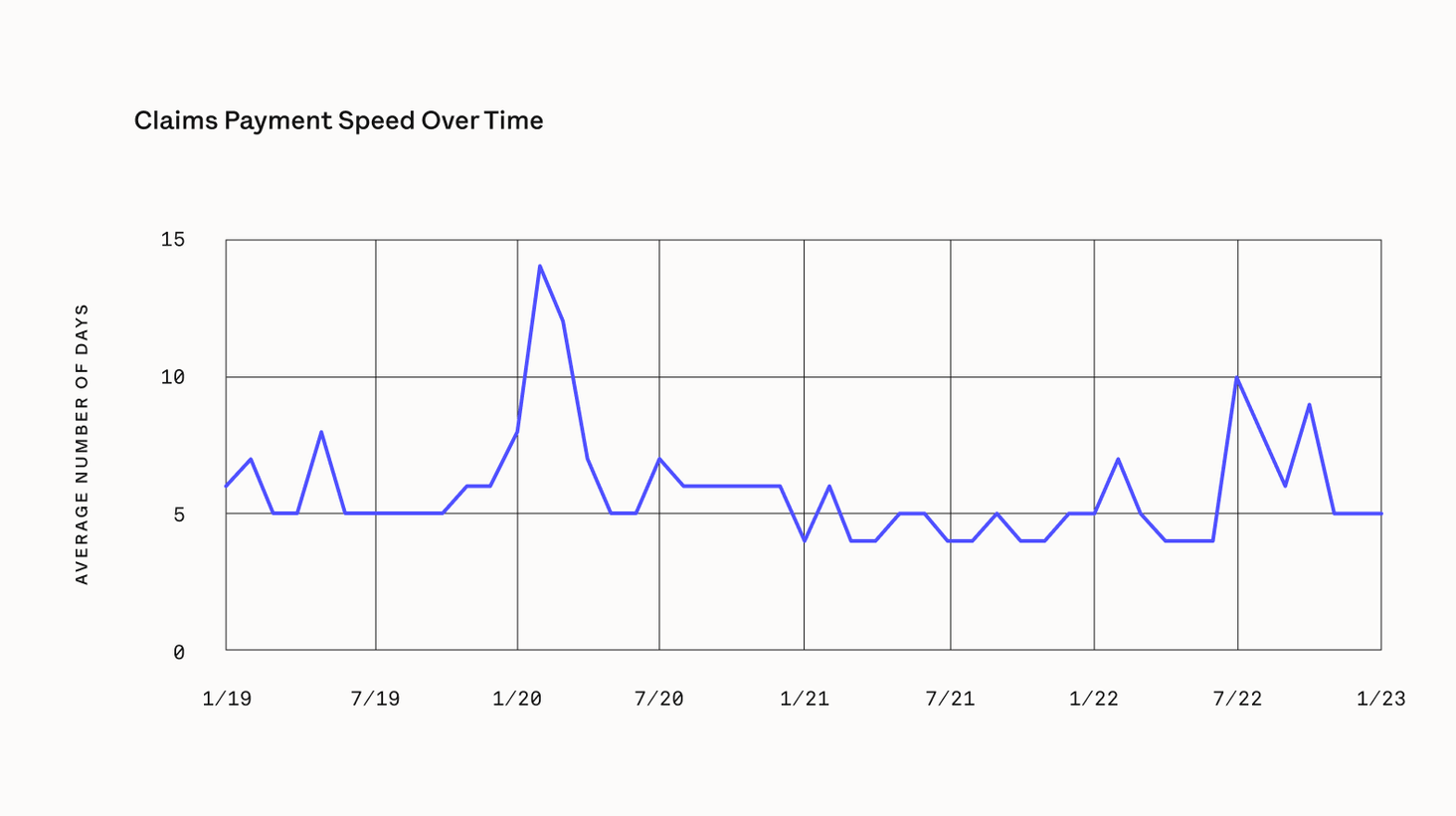
Provide better financial planning capabilities through better insights
Healthcare price variation is large, and insurers in theory have a great opportunity in providing actionable transparency. In practice, it is still hard to get good cost of care estimates. We built our own payments system so that we can query it in real time, when a member is looking for prospective cost of care. We track all cost estimates we generate and automatically compare them to the cost of the corresponding claims, when the service is ultimately done and the claims come in: the majority of our cost estimates are within 10% or $25 of the service cost, which enables members to accurately plan for their healthcare spending.
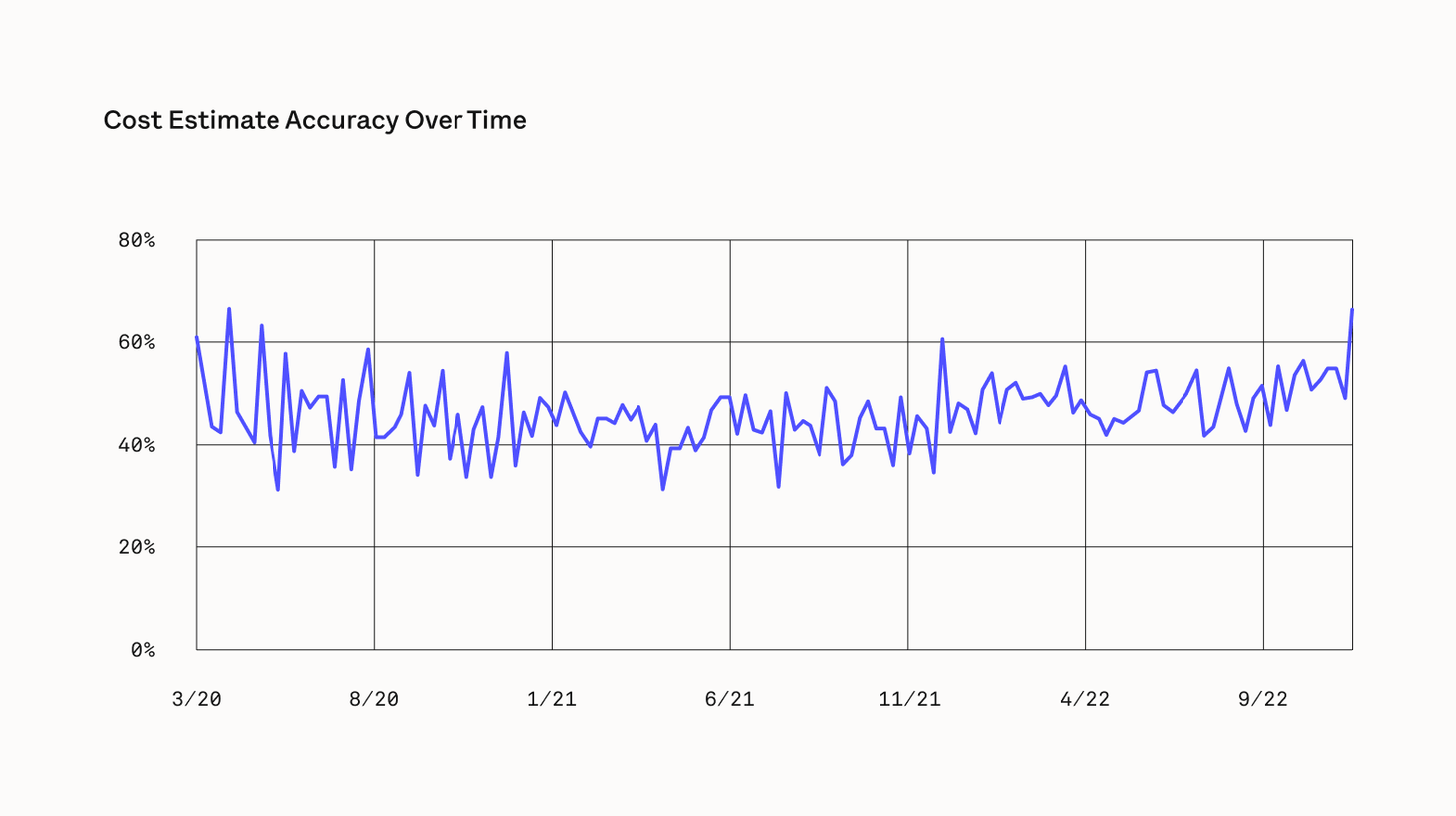
Actionable insights through deep learning
Deploying analytical models in healthcare suffers from two frequent issues: one, input data is incomplete or late; and, two, the models generate decent insights but nobody does anything with them. Owning our infrastructure and running on a unified tech architecture lets us deploy deep learning models in a way that is faster and more action-oriented. For example, we run a deep-learning model that is able to identify conditions in medical records more effectively and efficiently than is manually possible.
03
Modernizing: Authorize Care
Manage care through persuasion & personalized relationships
Prior authorizations and deductibles do work to reduce unnecessary healthcare utilization (for example, this 2022 study suggests that prior authorization reduces drug spending by 3.6%).11 They just can’t be the only tools used to drive better utilization. Our thesis is that better member engagement translates into better utilization.
Testing rapidly what works best in engaging members
We leverage technology and data to engage members and to proactively address and reduce risk. One way we do that is through Campaign Builder, our highly configurable engagement and automation platform that enables scalable, personalized interventions and automates workflows.
Built for non-technical users, we use Campaign Builder to build campaigns that deliver interventions with multiple touch points over time to drive behavior change. Interventions are automated and delivered via HIPAA-compliant communication channels and integrated with existing systems, EHRs, and third-party tools.
For example, our annual wellness appointment program delivers a roughly 15% increase in visits scheduled and a 20% reduction in no-shows. Programs focused on site of care use have seen a more than 13% reduction in ER visits.
Engaging members when they are looking for support
Our technology weaves clinical and non-clinical conversations in a single platform. Our custom-built CRM tool, Rosco, is a comprehensive management platform that empowers teams to engage members in critical moments of conversation. Handling member, provider, and facility data sources, Rosco provides care guides with key insights to meet our members’ needs, across the healthcare continuum.
It also is the CRM we use to run our inbound and outbound telephone campaigns. Rosco Task Manager (RTM) is built into the member’s profile and generates tasks for care guides to help members take action on. This tool takes advantage of the opportunity to engage members when they have initiated a phone interaction with us and provides care guides with the necessary information to speak to a specific member’s needs and situation. The Outbound Task Manager (OTM) is a tool designed to queue up tasks (particularly outbound calls) for a user to perform, facilitate the performance of the task, and record the results. At any point in time, we have over 100 RTM and OTM campaigns running that engage members in critical moments, and we’re getting high engagement.
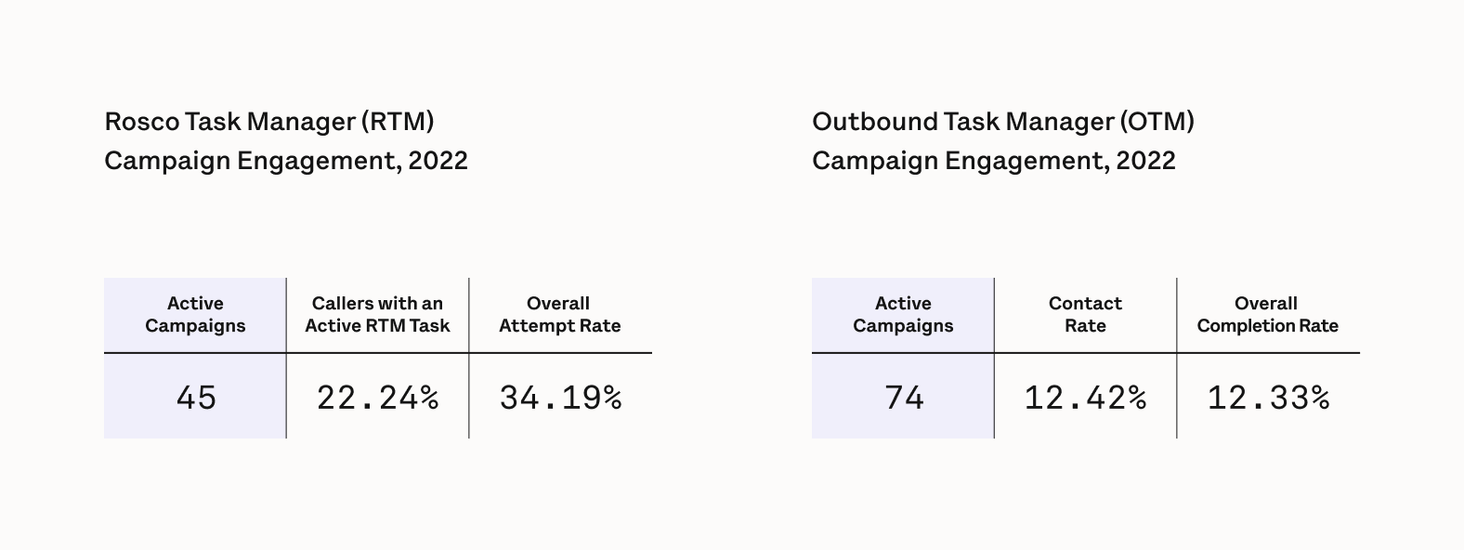
04
Modernizing: Manage Cost of Utilization
Route care in the network & pay for value
Recent price transparency data has shown that even for the same insurer at the same hospital for the same procedure, prices vary widely. Clearly, just contracting a provider network isn’t enough to create a more efficient delivery system. On top of our networks, we layer our care routing technology.
Route people to care
We help members find the best providers for them, with a clear line of sight into quality and cost. Our care routing tools recommend the best providers at the most affordable price to our members. The underlying algorithms use provider performance and personalized patient data to guide patients toward the providers and care options best suited for them, based on member satisfaction, care quality and cost efficiency. High member engagement is a necessary precursor to do this well. Members can then quickly generate cost estimates, and unlike for the rest of the industry which typically relies on pre-computed cost guesses, we adjudicate bundles of claims in real time to estimate costs. The chart below shows the percentage of members who viewed cost estimates before utilizing healthcare.
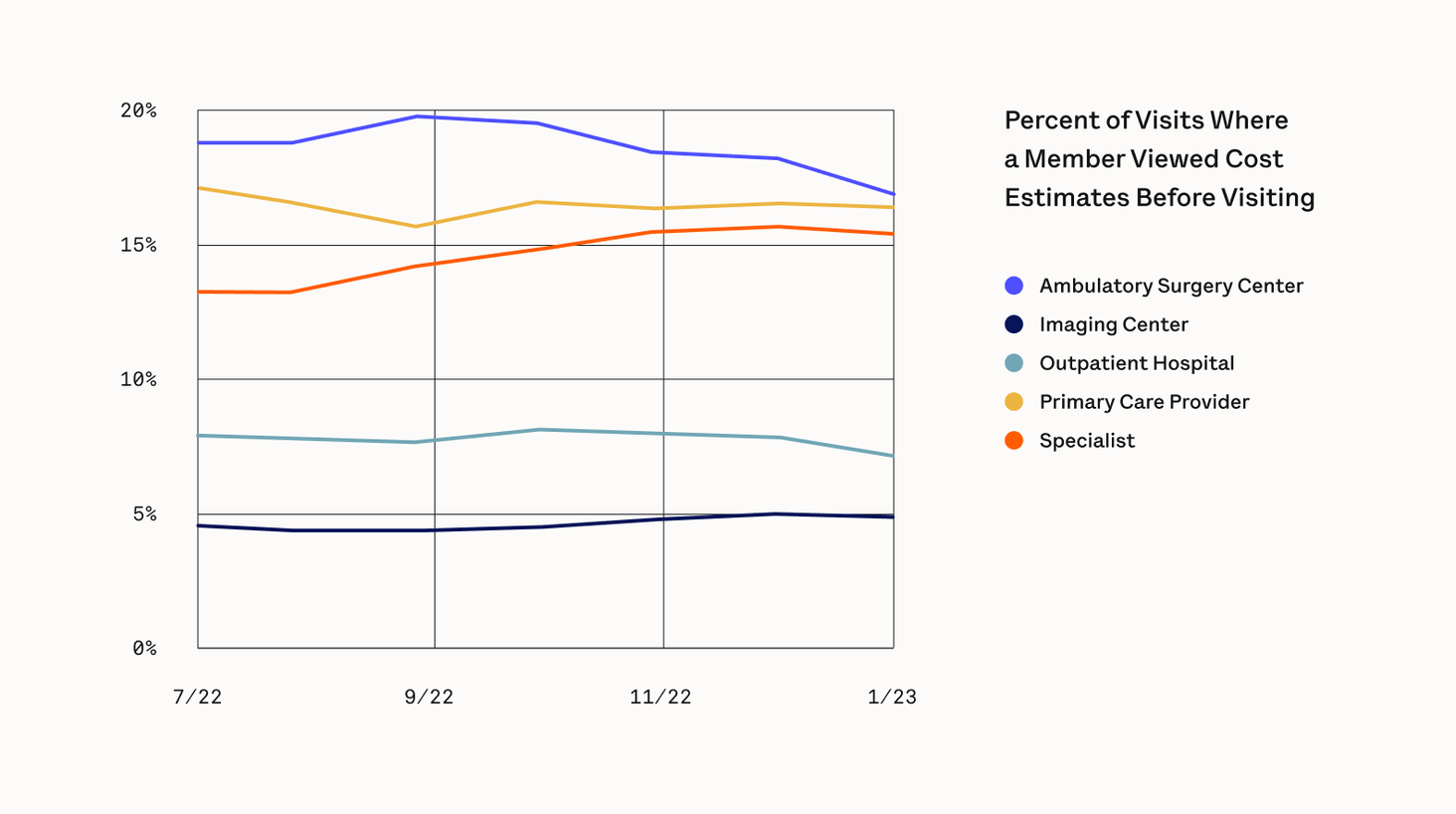
So these are our versions of the four core components of the “classical” health insurer.
However, are insurers really best positioned to even deliver these four functions? No. In our view, we believe the best insurer is one that builds these capabilities as a tech platform to power others, not just itself.
That is because other entities in the healthcare system (doctors, health systems, digital health players) are structurally better positioned to build risk-based, direct-to-consumer, longitudinal relationships than employers, or B2B-focused insurers. The classical insurer is destined to become obsolete, unless it evolves its capabilities and un-bundles.
That is how we ultimately think about the role that Oscar should play in the healthcare system. It is a long journey. We will talk through the data points we have that suggest we’re well on the way to making that happen below.

Unbundling the health insurer
Today, the vast majority of providers have not built direct acquisition capabilities, people are still surprised by unexpected bills and charges, and insurers largely struggle to retain members for longer than 3 years. Thus, very few market participants have an incentive to invest in long-term health outcomes, and old-school claims systems and providers’ inability to set their own incentives severely limit using financial levers to drive behavior change.
A better healthcare system would be one where providers and other non-insurers:
(1) can attract members, (2) save members money by engaging them directly, (3) retain members in long-term relationships and invest in their long-term health outcomes, allowing providers to share financially in the outcomes, (4) by directly controlling and personalizing incentives.
In other words, let’s take the four classic insurance capabilities into an unbundled, risk-based model that leverages the new world of APIs and interoperability for other players in the healthcare system. For example:
Unbundling how insurers acquire premium revenue
Instead of insurers, health systems should attract members into branded plans and manage them there, but they lack member acquisition and retention capabilities — our tools can help them with that.
Unbundling how insurers identify and reduce risk per member
Instead of insurers, digital health startups as an emerging channel know how to reduce costs in a particular area of care, but they lack the capabilities and the “reg(ulatory) tech” to tap into risk payment flows — our tools enable that.
Unbundling how insurers authorize care
Instead of national insurers, local payers have powerful local market presence, but use a multitude of claims and utilization management systems to manage their business and can’t nimbly respond to market dynamics — our tools help them with that.
Unbundling how insurers manage cost of utilization
Instead of insurers, risk-bearing physician groups have innovative clinical workflows and population health campaigns, but often can’t scale them and spread them to others — our workflow tools enable that.
Our platform evolves the four core components of a great classical insurer into the four components of a great unbundled insurer:
01 Any healthcare service becomes an insurance-like product →
02 Everything can be a personalized incentive →
03 Lifelong relationships motivate well care, not sick care →
This is a journey, but let’s review the data points we have to date.
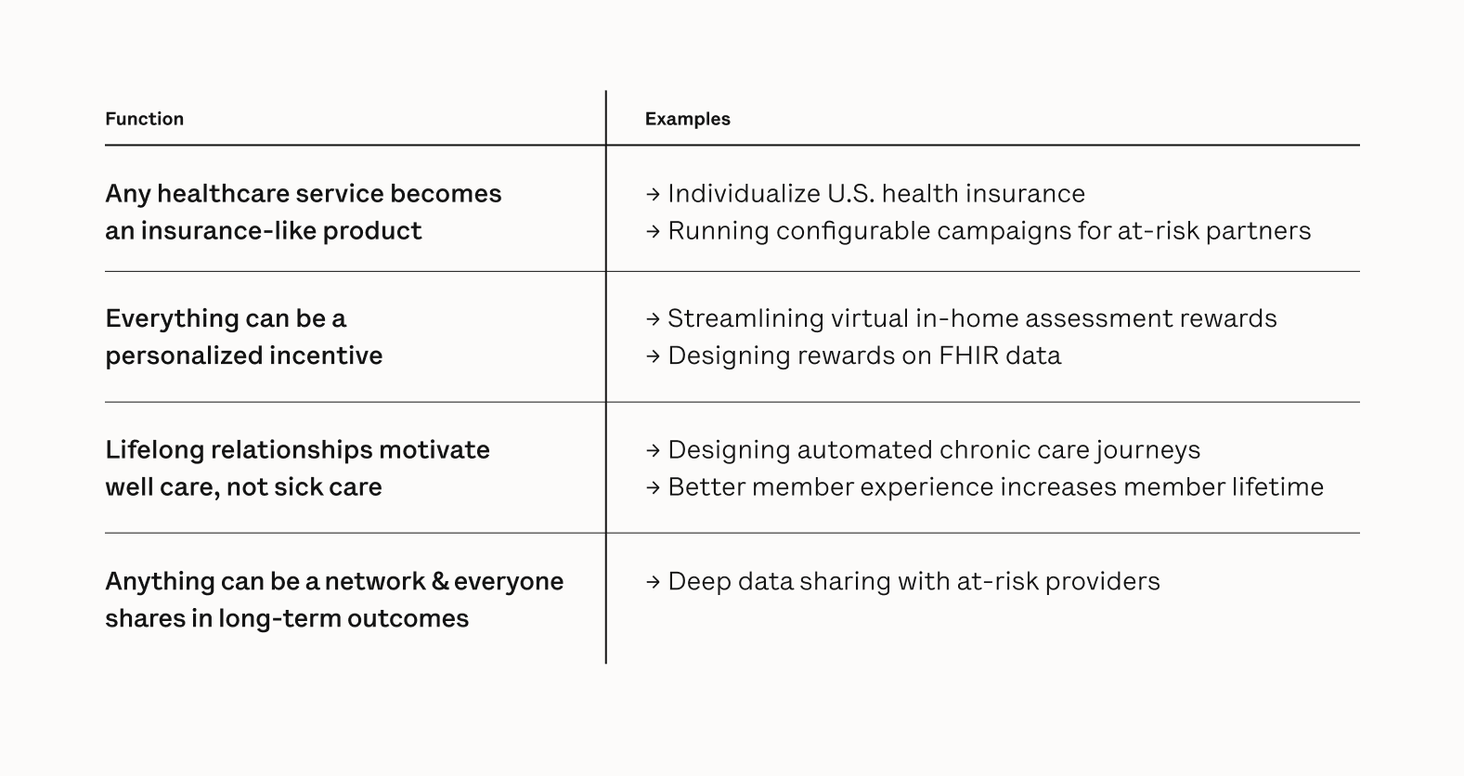
01
Unbundling: Acquire Premium Revenue
Any healthcare service becomes an insurance-like product
Individualize all U.S. health insurance
All healthcare markets would be more competitive if they were real consumer-driven markets — particularly employer segments. The potential for growth in the individual health insurance market through Individual Coverage HRAs, a 401 K-like, defined contribution-style health insurance offering where employers give employees stipends to buy health insurance on the marketplace, is a new vehicle that employers can use today to individualize healthcare.
Giving employees choice would likely result in them buying cheaper, more-tailored policies, too. And, according to a study published in the Wall Street Journal, after giving workers a HRA to purchase their health insurance of their choice, workers would take home an extra $160 billion in extra income. The federal government, now taxing that additional income, would receive between $46 billion and $65 billion in new tax revenue.
Today, we are already seeing that, in some states, some individual plans cost less than those offered by employers, making the benefit here an immediate reality.
Moreover, other health system players could start adopting the features built and utilized by insurance companies to drive down costs or optimize care outcomes. For example, health systems should deploy a “non-plan health plan” product that sits on top of our novel claims system — a lightweight, direct-to-consumer, branded app that lets health systems take advantage of our cost-savings and attribution tools that were produced to serve the insurance business, including care routing, to engage a membership base as an eventual on-ramp for their health plan.
A simple version of this is a recent configurable campaign that we launched for an at-risk health system partner to drive members in select zip codes to their underutilized primary care providers, leveraging a series of different messages to assess which would most significantly impact behavior.
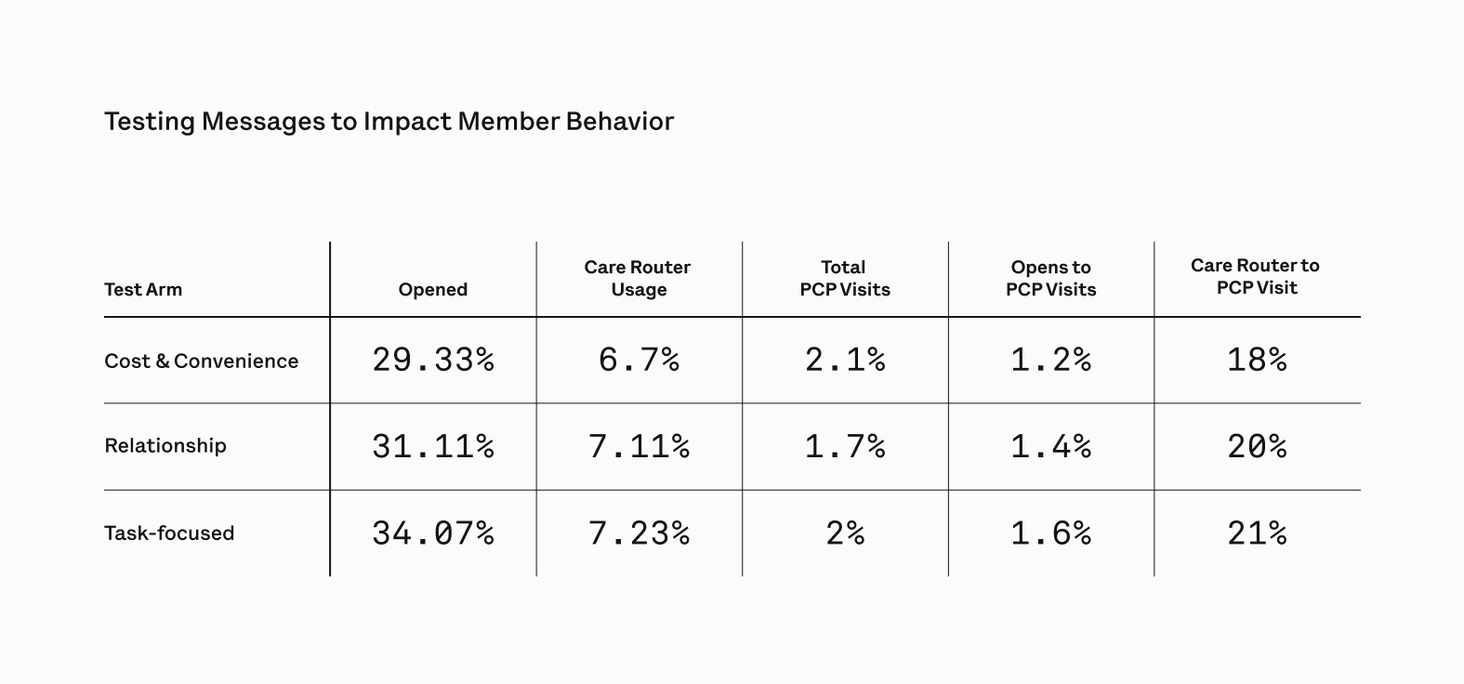
Tech companies run many A/B tests in parallel, while health plan designs move slowly. We can change that.
Super-fast iteration of new feature ideas
We quickly iterate new feature ideas so that we can meet the ever-changing needs of the consumer markets.
For example, when we launched our Virtual Primary Care plan offering, our payments platform allowed us to dynamically waive cost shares for certain visits ordered by members’ virtual providers, creating a first-of-its kind virtual plan design. We went from concept to launch in ~8 months.
Once it was launched, fast product iteration and launch of member engagement campaigns that tested four hypotheses reduced first-time patient no-show rates for our Virtual Primary Care offering by 44% over 7 months.
Running on a coherent tech architecture that is set up for experimentation is also an obvious use case for Large Language Models. We are testing the fine-tuning of a language transformer that lets us describe in natural language what a new campaign should do, and it creates the campaign's configuration.
Unbundling: Identify & Reduce Risk per Member
Everything can be a personalized incentive
Most people have trouble understanding what copays and coinsurance are. But well-designed financial incentives work. So: everything can be a personalized incentive.
For example, personalized discounts delivered in real-time can help improve medication and treatment plan adherence.
When we offer members a $25 gift card for completing a Virtual Health Assessment (VHA) with an Oscar Medical Group provider, 26% of contacted members complete it, compared to 8% where the incentive is unavailable. During the assessment, the provider reviews the member's medical history, current medications, and can answer questions the members have.
But more convenience takes this another step further: in early 2022, we launched the ability for members with online accounts to self-schedule VHA, and late last year, we launched a way for members without online accounts to do so. Within a few months of launch last year, almost 20% of virtual in-home appointments were booked by members via digital channels.
As another example, interoperability allows us to push data back into providers’ EHRs or share it with other insurers so that they can better serve their members with real-time information and analytics. This allows us to turn nearly every interaction into a personalized incentive.
Oscar’s Campaign Builder enables rapid development of automated programs on top of aggregated and continuously updating data. The shift to standardized FHIR (Fast Healthcare Interoperability Resources) data models across the industry means that Campaign Builder can be quickly deployed for new organizations who historically would have an expensive prerequisite step of aggregating and standardizing their data. New federal rules will require payers and providers to make their data available in FHIR format to everyone else in the healthcare system.
For example, any healthcare organization could use a stream or recurring update of encounter data to programmatically retrieve medical records for their patients post-visit or use medication data to identify a population to target with a medication adherence campaign. For a single organization, pairing Campaign Builder with their FHIR data warehouse could yield dozens of programs that drive value across member and patient engagement, medical cost savings, and administrative process efficiency.
Unbundling: Authorize Care
Lifelong relationships motivate well care, not sick care
Physical activity for those aged 43-65 lowers costs significantly when reaching Medicare age12 — to the point where society could pay everyone $6 per hour of working out for those 22 years. And yet, society can’t — because lifelong relationships don’t “pay” in U.S. healthcare. But really, for risk-bearing providers in a consumerized health insurance market: lifelong relationships motivate well care, not sick care.
As a step towards that goal, we have built highly configurable healthcare experiences that can be quickly spun up by a mix of clinical and non-clinical experts, without the extensive support of engineering or product resources: we do that by assembling long-running Care Journeys in our Campaign Builder tool. A great example of their use is in our virtual primary care plans, where the care journeys constitute a series of automated messages designed to drive specific clinical outcomes. The team works backwards from a HEDIS gap or specific behavior to drive engagement and action, balancing channels as necessary for optimal outcomes.
These Care Journeys enable our virtual providers to work at the top of their license, with no reminder working in a vacuum and providers drive home the importance of screenings, vitals logging, and lab testing.
The results show that we are able to rapidly drive outcomes for patients by using this automated model, particularly with patients previously unreached by network PCPs.
02
03
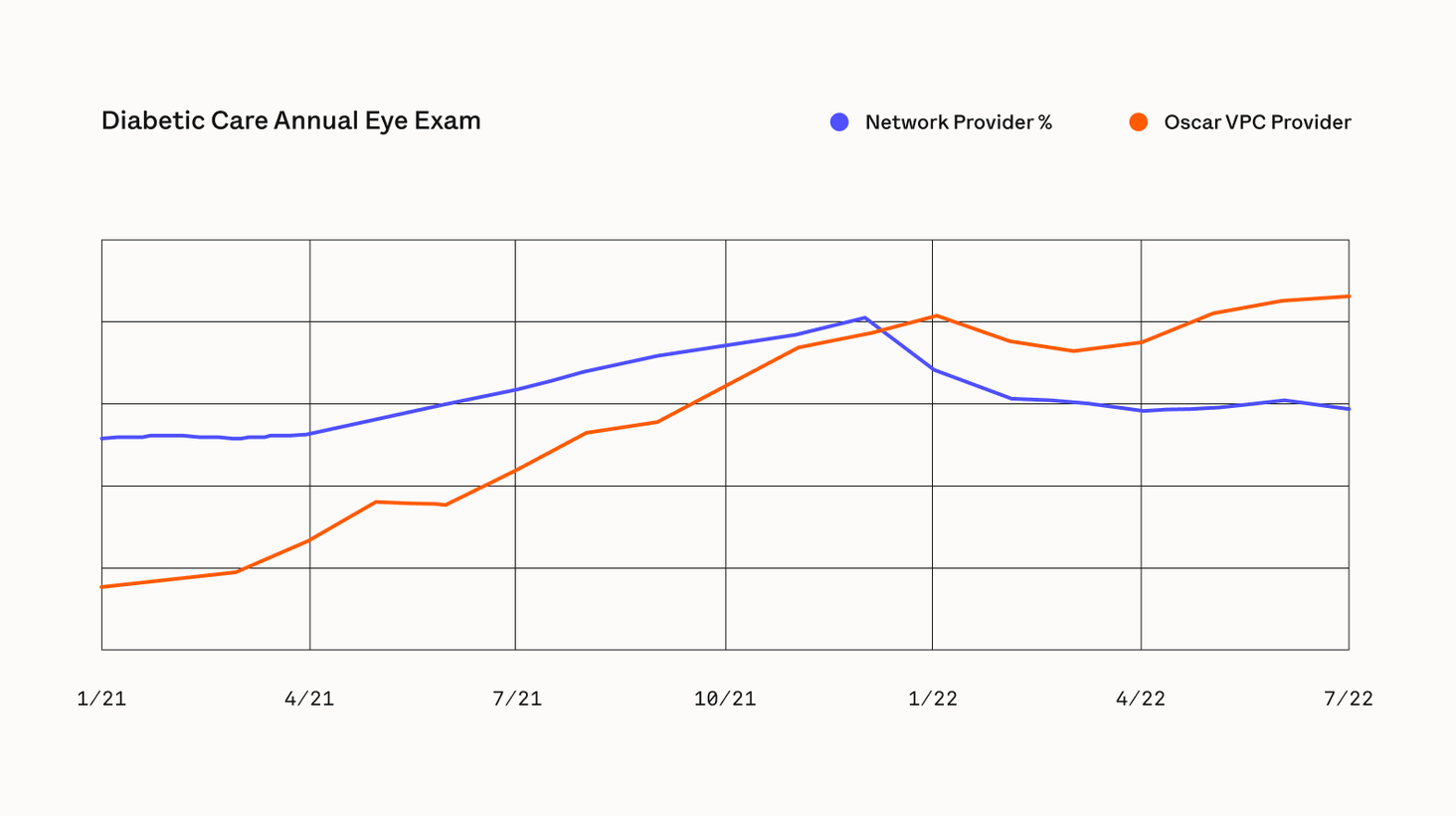
We design these together with provider partners. Last year, one of our system partners asked to design a care journey for diabetic patients to schedule critical appointments including follow ups and foot exams, after their previous efforts had fallen flat. Text messages prompted members to schedule a visit with a physician in the health system provider network and followed up systematically. 41% of members opened the messages, and 11-13% booked appointments (depending on the clinical segment).
Our data suggests that a better member experience creates a stickier product, even when prices are increased. Recent data shows that digitally-engaged members experiencing large price increases are up to 11% more likely to stay with us YoY.
Unbundling: Manage Cost of Utilization
Anything can be a network & everyone shares in long-term outcomes
Only 15% of your healthcare outcomes are driven by clinical care — 40% by social determinants, 20% by behavior, and 25% by genetics and environment.13 Then why do insurer networks only include clinical care delivery? So: anything can be a network & everyone shares in long-term outcomes.
That’s what we should be building towards in the healthcare system. Today, key parts of Oscar’s tech stack — including assignment & attribution capabilities, risk adjustment models, and claims history — can be combined to create action-oriented insights for our provider partners. The ability to extract and action against dynamic insights has powered our partnership model with providers and enables us to quickly turn around requests for new dashboards or views into data, in ways that are configurable, based on feedback and as we learn and grow with our partners.
04
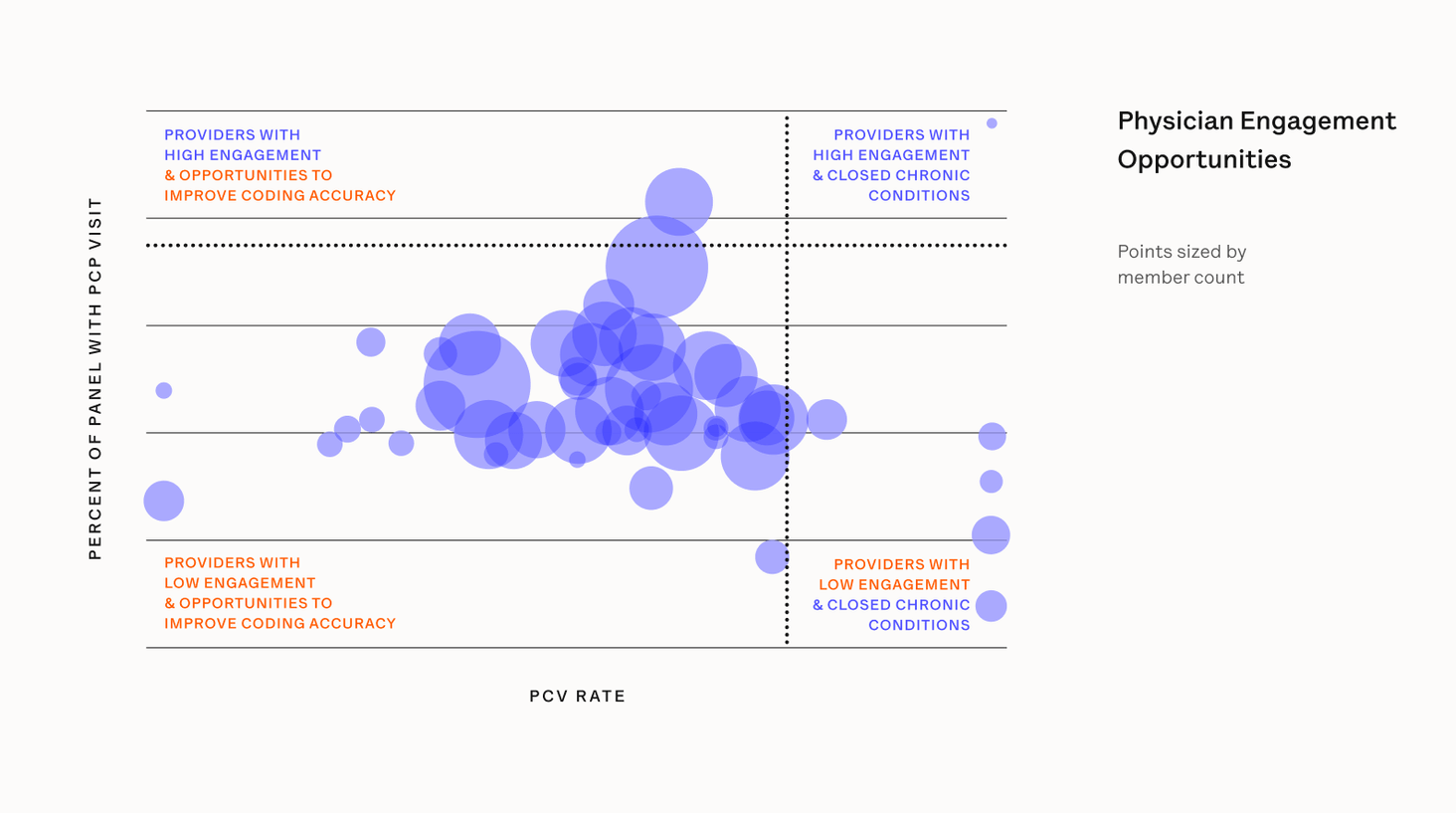
A demo of this technology and how we are leveraging it with our providers can be seen here:

Conclusion
In healthcare, it is easy to convince oneself that the more things change, the more they stay the same.
After all, almost everything we’re seeing today has in some shape or form been tried before. What was called capitation in the 1990s is now called risk contracting. The ACA’s Triple Aim used to be called the Iron Triangle. Humana used to be a hospital chain that owned an insurance company. The hottest healthcare model of the 1990s was risk-bearing physician practices in gatekept HMOs, the hottest model of the 2000s was the exact opposite (broad-network PPOs), and now we’re going back to the future. The first time Google Health shuttered was on January 1, 2012. And Apple once made a handheld called the Newton. Meanwhile, the only constant is that U.S. healthcare costs rose from 8% to 18% of GDP, and went from being in the middle-of-the-pack of OECD countries to exceeding every other OECD country by a factor of 2.
But across industries, what drives step-changes in innovation is the confluence of several big, simultaneously occurring trends.
Digital music required fast broadband in student dorms plus the development of 10x higher compression with the MP3 format. Just one of them wasn’t enough, but both of them together transformed an industry.
Similar shifts have been occurring in healthcare. Before the 2008 stimulus bill, most U.S. hospitals and physician practices didn’t have EHRs, now they all have them. In 2010, very few Americans were on deductibles over $1,000, now it’s more than half. Individual Coverage HRA (ICHRA) was introduced in 2020 and allows employers to reimburse employees for some or all of the premiums that the employees pay for health insurance purchased on their own. More Americans than ever are choosing their own health plans, in Individual and MA markets. CMS will continue to push the system to value and towards data interoperability. Every other industry has been moving its data into the cloud, but Amazon Web Services wasn’t even HIPAA-compliant until June 2013. (And the Apple Newton now has some notable successors.)
These seem to us like meaningful shifts.
Healthcare is becoming more individualized, more digital, and more value-based, and there is a great chance that it isn’t just going back into one of its decade-long repetitive cycles.
More non-healthcare companies than ever before are entering healthcare. Ultimately, every one of them will need to act like mini-insurers, taking risk and tapping into the existing payment flows in this $4T market.
Others are trying to build shareable technology in healthcare, but it just hasn’t really been done from the insurer’s point of view — still one of the most powerful entities in the healthcare system. A decentralized insurer is uniquely set up to enable others to build trustworthy entry points to healthcare, to compile the most intelligent & quantitative individual model of a member’s needs & behavior, to route care in optimal sequences, and to pave the way with microdosed incentives.
That is the machinery we have been building:
FIRST
As a health insurer enabling members and providers to navigate the system
SECOND
By unbundling the insurer to enable risk-bearing entities to refactor the system


Footnotes
1 Medical Group Management Association (MGMA) (2022, August 18). Data Report: Patient Access and Value-Based Outcomes Amid the Great Attrition. MGMA. https://www.mgma.com/data-ops22
2 Finn Partners (2016, February 9). Finn Partners National Survey Reveals How Fragmented Health System Places Greater Burden On Patients. PR Newswire. https://www.prnewswire.com/news-releases/finn-partners-national-survey-reveals-how-fragmented-health-system-places-greater-burden-on-patients-300217167.html
3 Sahni, N., Mishra, P., Carrus, B., Cutler, D. (2021, October 20). Administrative simplification: How to save a quarter-trillion dollars in US healthcare. McKinsey & Company.
https://www.mckinsey.com/industries/healthcare-systems-and-services/our-insights/administrative-simplification-how-to-save-a-quarter-trillion-dollars-in-us-healthcare
4 Kronick, R., (2020, January 29). Why Medicare Advantage Plans Are Being Overpaid By $200 Billion And What To Do About It. Health Affairs. https://www.healthaffairs.org/do/10.1377/forefront.20200127.293799/full/
5 Kaiser Family Foundation (2008, October 14). Health Care Costs and Election 2008. https://www.kff.org/health-costs/issue-brief/health-care-costs-and-election-2008/
6 Kaiser Family Foundation (2022, October 27). 2022 Employer Health Benefits Survey: Percentage of Covered Workers Enrolled in a Plan With a General Annual Deductible of $1,000 or More for Single Coverage, by Firm Size, 2009-2022 10020.
https://www.kff.org/report-section/ehbs-2022-section-7-employee-cost-sharing/attachment/figure-7-13-13/
7 Ukert, B., PhD, Esquivel-Pickett, S., PhD. (2022, May 9). Disparities in Health Care Use Among Low-Salary and High-Salary Employees (Table 3). The American Journal of Managed Care (AJMC).
https://www.ajmc.com/view/disparities-in-health-care-use-among-low-salary-and-high-salary-employees
8 Jiang, D., BA; Herrin, J., PhD; Van Houten, H., BA; et al. (2023, January 20).
Evaluation of High-Deductible Health Plans and Acute Glycemic Complications Among Adults With Diabetes. JAMA Network Open. https://jamanetwork.com/journals/jamanetworkopen/fullarticle/2800697
9 Herzlinger, R., Klein, J. (2018, July 1). The IRS Can Save American Health Care. The Wall Street Journal.
https://www.wsj.com/articles/the-irs-can-save-american-health-care-1530477705
10 Dunn, A., Gottlieb, J., Shapiro, A.,Sonnenstuhl, D., Tebaldi, P. (July 2021. Revised January 2023). A Denial a Day Keeps the Doctor Away. National Bureau of Economic Research.
https://www.nber.org/system/files/working_papers/w29010/w29010.pdf
11 Brot-Goldberg, Z., Burn, S., Layton, T., Vabson, B. (January 2023). Rationing Medicine Through Bureaucracy: Authorization Restrictions In Medicare. National Bureau of Economic Research. https://www.nber.org/system/files/working_papers/w30878/w30878.pdf
12 Coughlan, D., Saint-Maurice, P., Carlson, S., Fulton, J., Matthews, C. (2021, March 5). Leisure time physical activity throughout adulthood is associated with lower medicare costs: evidence from the linked NIH-AARP diet and health study cohort. BMJ Open Sport & Exercise Medicine. https://bmjopensem.bmj.com/content/7/1/e001038
13 McGovern, L. ( 2014, August 21). The Relative Contribution of Multiple Determinants to Health. Health Affairs. https://www.healthaffairs.org/do/10.1377/hpb20140821.404487/full/
Oscar Medical coverage is underwritten by Oscar Insurance Company located in New York, New York. Plans sold in New York are underwritten by Oscar Insurance Corporation located in New York, New York. Plans sold in Florida are underwritten by Oscar Insurance Company of Florida. Plans sold in New Jersey are underwritten by Oscar Garden State Insurance Corporation. Administrative Services for all plans provided by Oscar Management Corporation. Plans sold in Texas use policy and associated COC form numbers OSC-TX-IVL-HMO-EOC-2025-HIX OHIN-134128348; OSC-TX-IVL-HMO-EOC-2025 OHIN-134128297; GUIDED OSC-TX-IVL-HMO-GOLD-GUIDED-CARE-EOC-2025 OHIN-134128360; OSC-TX-IVL-EOC-2025 OHIN-134080911;OSC-TX-IVL-EOC-2025-HIX OHIN-134080906; OSC-TX-S-IVL-EOC-2025-HIX OHIN-134079760; OSC-TX-S-IVL-EOC-2025 OHIN-134079760. Plans sold in Virginia use policy and associated form numbers VA ON OSC-VA-IVL-EOC-2025-HIX OHIN-134065976; VA OFF OSC-VA-IVL-EOC-2025 OHIN-134065976.
HMO products are offered by Oscar Insurance Corporation and Oscar Buckeye State Insurance Corporation in Ohio, Oscar Health Plan, Inc. in Arizona and Illinois, Oscar Health Plan of Pennsylvania, Inc in Pennsylvania, Oscar Health Plan of Georgia in Georgia, Oscar Health Plan of North Carolina, Inc. in North Carolina, Oscar Managed Care of South Florida, Inc. in Florida, Oscar Health Plan of New York, Inc. in New York, and Oscar Managed Care in Texas.
All insurance policies and group benefit plans contain exclusions and limitations. For availability, costs, and complete details of coverage, contact a licensed agent or Oscar sales representative.

© 2025 Oscar Insurance
